(推荐)高一英语必修三Unit4Unit4说课稿
- 格式:doc
- 大小:20.50 KB
- 文档页数:3
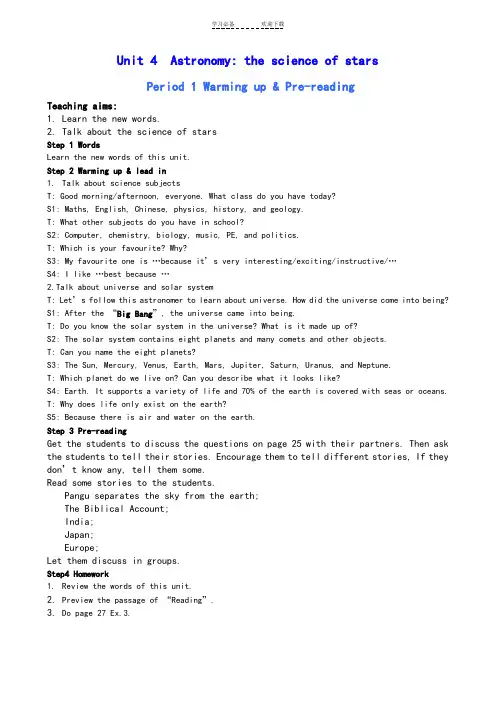
Unit 4 Astronomy: the science of starsPeriod 1 Warming up & Pre-readingTeaching aims:1.Learn the new words.2.Talk about the science of starsStep 1 WordsLearn the new words of this unit.Step 2 Warming up & lead in1.Talk about science subjectsT: Good morning/afternoon, everyone. What class do you have today?S1: Maths, English, Chinese, physics, history, and geology.T: What other subjects do you have in school?S2: Computer, chemistry, biology, music, PE, and politics.T: Which is your favourite? Why?S3: My favourite one is …because it’s very interesting/exciting/instructive/…S4: I like …best because …2.Talk about universe and solar systemT: Let’s follow this astronomer to learn about universe. How did the universe come into being? S1: After the “Big Bang”, the universe came into being.T: Do you know the solar system in the universe? What is it made up of?S2:The solar system contains eight planets and many comets and other objects.T: Can you name the eight planets?S3: The Sun, Mercury, Venus, Earth, Mars, Jupiter, Saturn, Uranus, and Neptune.T: Which planet do we live on? Can you describe what it looks like?S4: Earth. It supports a variety of life and 70% of the earth is covered with seas or oceans. T: Why does life only exist on the earth?S5: Because there is air and water on the earth.Step 3 Pre-readingGet the students to discuss the questions on page 25 with their partners. Then ask the students to tell their stories. Encourage them to tell different stories, If they don’t know any, tell them some.Read some stories to the students.Pangu separates the sky from the earth;The Biblical Account;India;Japan;Europe;Let them discuss in groups.Step4 Homework1.Review the words of this unit.2.Preview the passage of “Reading”.3.Do page 27 Ex.3.Unit 4 Astronomy: the science of starsPeriod 2 Reading and ComprehendingTeaching Aims: Enable the Ss to say something about astronomyHelp the students to form a good habit of readingCultivate the Ss' awareness of protecting the earth.Teaching Importance: How to improve the Ss'ability to understand how life began on the earthTeaching Methods:Task--based methodTeaching Procedure:Step1. Warming up1.Free talk2.Review the words of Unit 4 by playing chess on the blackboard.Step2 Leading-in1.Talk about some pictures.2.Watch a video and then ask the Ss to put the pictures on the screen into a rightorder.Step3 ReadingTask 1 SkimmingRead the passage quickly and join the main idea for each paragraph.Para.1a)The arrival of humans and their impact on the earthPara.2 b)The development of plants and animals on the earthPara.3 c)A widely accepted theory about the formation of the universePara.4 d)The importance of water for lifePara.5 e)The formation of the earthTask 2 ScanningRead the passage carefully and then fill in the blanks with different kinds of living things.Task 3 Careful Reading:Finish the summary according to the text:After the “big bang”, the earth was still just a cloud of _______,it _______loudly with fire and rock, which were _____ to produce the_________, carbon dioxide and other gases. Then ________ grew. They multiplied and filled the oceans and seas with _____. Many millions of years later the first ________ began to appear on land. When the plants grew to forest, _____ appeared for the first time. They produced young generally by __________. When dinosaurs disappeared, ________ became more important.Task 4 Post ReadingDiscuss in groups.1.What problems have been caused by humans to the earth?2.How to protect the earth and make it a better place to live on?Step 4 Homework1. Search the Internet for the imformation of the development of life.2. Read the passage carefully and try to find out key points.Period 3 Reading (2)Teaching goals:1.Learn the usage of some difficult words and expressions.2.Train the students’ ability to remove the difficulties while reading.Teaching important points:Train the students’ ability to cooperate with others.Step 1 Revision1.Check up the homework.2.Have a quiz of the words.Step 2. Language points1. It exploded loudly with fire and rock, which were in time to produce the watervapour.Which leads non-restrictive attributive clause.in time: sooner or later; eventuallyI will see him in time.In time ( for sth/to do sth): not lateShe will be back in time to prepare dinner.In/out of time: in/not in the correct time2. Whether life will continue on the earth for millions of years to come will dependon whether this problem can be solved.To come: serves as attributiveShe is the last person to do such a thing.Depend on: something might only happen or be true if the circumstances are rightfor itOur success depends on whether everyone works hard or not.3.…by laying eggs.lay-laid-laid-laying 放, 把...... 放在......; 产卵He laid his books on the desk.4.give birth to1) 生(孩子)She’s just given birth to a healthy baby girl.她刚刚生了个健康的女婴。
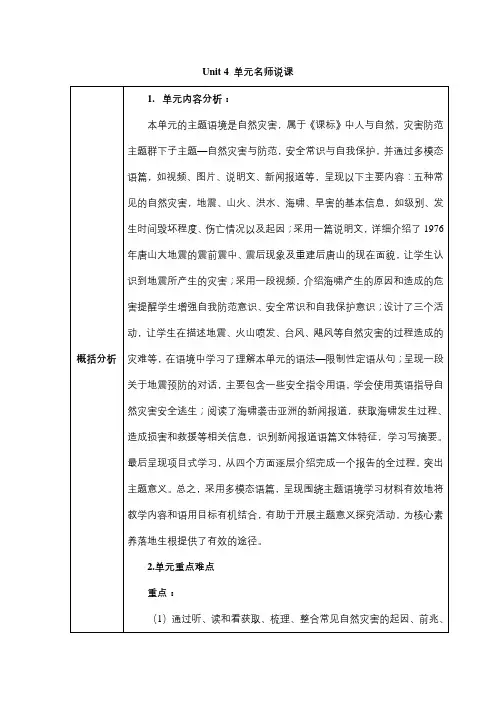
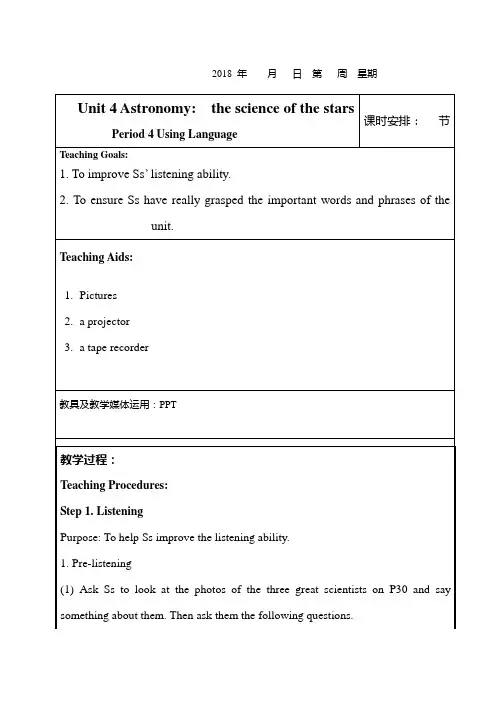
2018 年月日第周星期①Do you know about some background knowledge of these three great scientists ?②Can you say something about them?(2) Ask Ss to look through Ex1 and Ex2 on P30 and get fully prepared for listening to the tape.2. Listening(1) Ask Ss to listen to the tape and finish Ex1 on P30.(2) Play the tape again and ask Ss to check the answers in pairs.(3) Ask Ss to listen to the tape for the third time and finish Ex2 on P30. Then have some of them explain their answers.Step 2. ReadingPurpose : To get Ss to know about human being’s feelings of visiting the moon. 1. Fast readingAsk Ss to look through the text quickly and choose the best answer to the following question.The passage is mainly about ____?A. introduction of the moonB. the gravity that I felt on my way to the moonC. my visit to the moonD. my friend Yanping, an astronomer Suggested Answer: C.2. Intensive readingAsk Ss to read the text carefully and finish the following exercises.(1) According to the text, we know that the force of the gravity would change_____ times.A. 2B. 3C. 4D. 5(2) When did the author feel strongest of the gravity of the earth?A. On the moon.B. On the half way to the moon.C. At the very beginningD. On their leaving from the moon(3) What causes the writer to feel that he becomes weightless on the moon?A. SpaceshipB. GravityC. His friendD. His Good feelings of the moon(4) From the text we can know if a man grows up on the moon, _____.A. he will grow taller than on the earthB. he will grow shorter than on the earthC. he will become fatterD. he will become weightless Suggested Answers: (1) B (2) C (3) B (4) AStep 3. Speaking and writingPurpose: To get Ss to learn how to prepare a list of things used for going to the moon.To practice the writing ability of Ss.1. Divide the whole class into 6 groups. Let Ss discuss with their group members what they might need to go to the moon. Meanwhile, ask one student of each group to write down the important parts of their discussion.2. After the discussion Ss have had some knowledge of the things they would need if they were going to the moon. Get them to describe the three ways in which gravity changed for Li Yanping and how his weight changed..3. Then Ss to write a short passage explaining three problems they might meet on the moon as well as the solutions to these difficulties. Before writing, they can have a discussion.Step 4. Consolidation1. Ask Ss to finish Ex2 and Ex3 on P63~P64 and let them check the answers together.2. Ask Ss to finish the following exercises.(1) Fill in the blanks with proper words according to the given information.①The scientific study of the stars is called a______________.②Eating too much during the Spring Festival can do great h_______ to our health.③The patient’s health is g___________ improving with the help of the doctor.④The mixture of gases that surround the earth is called a_____________.⑤People can find lots of v___________ scenes in some American films.⑥Hearing the exciting story, almost everyone in the room _____________(爆发) with laughter.⑦The forest __________(延伸) as far as the river bank.⑧The wife was much ____________ (失望的) at her husband’s absence.⑨Marx was _________ (强迫) to leave his motherland for political reasons.⑩There is much dust __________ (漂浮) in the air.Suggested Answers: ①astronomy ②harm ③gradually ④atmosphere⑤violent ⑥exploded ⑦spreads ⑧disappointed ⑨forced ⑩floating(2) Finish the following sentences according to the Chinese.①______________________________________ (使我苦恼的) is that I haven't heard from him recently.②Do not read books in the poor light as it is _____________________ (对你的眼睛有害).③_____________________ (随着时间的推移), we are getting better with each other.④_____________________________________________ (我过去在工厂工作了十年) has a great and active effect on my life.⑤Please try to come back early _______________________________. (既然一切都安排好了)Suggested Answers:①What makes me upset / annoyed ②harmful to your eyes ③As time goes by ④That once I worked in a factory for ten years ⑤now that everything has been arranged(3) Choose the best answer to the following sentences.①The Americans are eating _____ vegetables today as they did before.A. more than twiceB. more than twice as manyC. twice over as manyD. over twice as much②If you always work so hard like this, you will ____ sooner or later..A. break upB. break out C break down D. break in③—Will you go out for shopping this Sunday?—Well, ___________.A. I would like to go.B. it all dependsC. I have a lot of work to doD. certainly not④Beyond _____ stars the astronaut saw nothing but _____ space.A. the; /B. /; theC. /; /D. the; the⑤_____ you have got a chance, you might as well make use of it.A. AfterB. AlthoughC. As soon asD. Now thatSuggested Answers: ①B ②C ③B ④A ⑤DStep 5. Homework1. Ask Ss to use the words and phrases learned in this unit to write a short passage about their own opinions on traveling to space.2. Ask Ss to preview the next period.课后反思:。
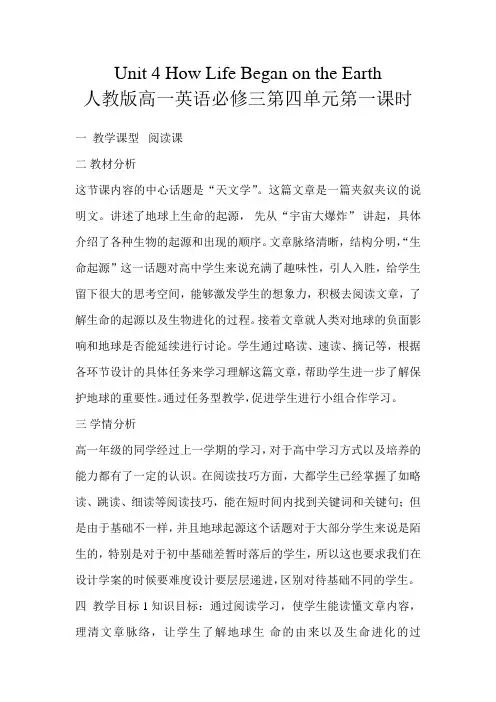
Unit 4 How Life Began on the Earth人教版高一英语必修三第四单元第一课时一教学课型阅读课二教材分析这节课内容的中心话题是“天文学”。
这篇文章是一篇夹叙夹议的说明文。
讲述了地球上生命的起源,先从“宇宙大爆炸”讲起,具体介绍了各种生物的起源和出现的顺序。
文章脉络清晰,结构分明,“生命起源”这一话题对高中学生来说充满了趣味性,引人入胜,给学生留下很大的思考空间,能够激发学生的想象力,积极去阅读文章,了解生命的起源以及生物进化的过程。
接着文章就人类对地球的负面影响和地球是否能延续进行讨论。
学生通过略读、速读、摘记等,根据各环节设计的具体任务来学习理解这篇文章,帮助学生进一步了解保护地球的重要性。
通过任务型教学,促进学生进行小组合作学习。
三学情分析高一年级的同学经过上一学期的学习,对于高中学习方式以及培养的能力都有了一定的认识。
在阅读技巧方面,大都学生已经掌握了如略读、跳读、细读等阅读技巧,能在短时间内找到关键词和关键句;但是由于基础不一样,并且地球起源这个话题对于大部分学生来说是陌生的,特别是对于初中基础差暂时落后的学生,所以这也要求我们在设计学案的时候要难度设计要层层递进,区别对待基础不同的学生。
四教学目标 1 知识目标:通过阅读学习,使学生能读懂文章内容,理清文章脉络,让学生了解地球生命的由来以及生命进化的过程 2 能力目标:通过略读、速读、摘记等培养学生的文本解读能力帮助学生形成有效学习策略,提高自主阅读的能力;在质疑,小组探究,同伴互助学习过程中,培养学生独立思考,推理,判断和创造性思维的能力和合作学习策略。
3 情感目标:通过对文章的学习及课堂活动参与激发学习热情,产生学习英语的浓厚兴趣;了解地球上生命的起源及其发展过程,并学会用科学的眼光看待事物,激发学生探索科学的热情。
引起他们对地球未来的关注,对地球面临危机的思考,意识到爱护地球,关爱生命的重要性。
五教学重点难点1. 让学生了解地球生命进化的历程,培养学生获取,分析和处理信息的能力。
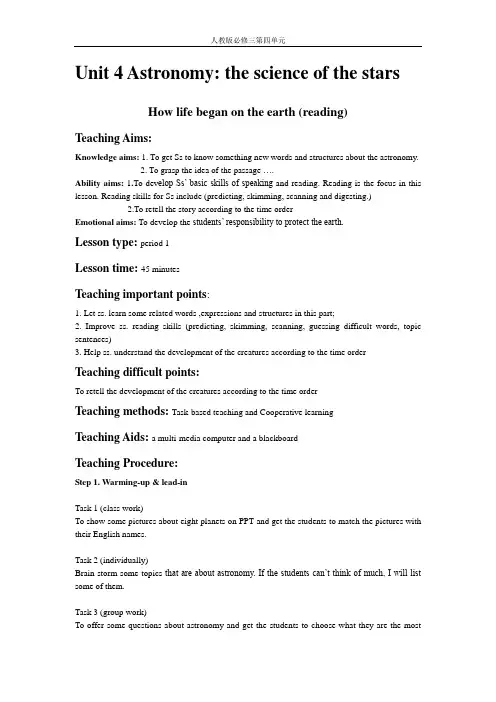
Unit 4 Astronomy: the science of the starsHow life began on the earth (reading)Teaching Aims:Knowledge aims: 1. To get Ss to know something new words and structures about the astronomy.2. To grasp the idea of the passage ….Ability aims: 1.To dev elop Ss’ basic skills of speaking and reading. Reading is the focus in this lesson. Reading skills for Ss include (predicting, skimming, scanning and digesting.)2.To retell the story according to the time orderEmotional aims: To develop the students’ responsibility to protect the earth.Lesson type:period 1Lesson time: 45 minutesTeaching important points:1. Let ss. learn some related words ,expressions and structures in this part;2. Improve ss. reading skills (predicting, skimming, scanning, guessing difficult words, topic sentences)3. Help ss. understand the development of the creatures according to the time order Teaching difficult points:To retell the development of the creatures according to the time orderTeaching methods: Task-based teaching and Cooperative learningTeaching Aids: a multi-media computer and a blackboardTeaching Procedure:Step 1. Warming-up & lead-inTask 1 (class work)To show some pictures about eight planets on PPT and get the students to match the pictures with their English names.Task 2 (individually)Brain-storm some topics that are about astronomy. If the students can’t think of much, I will list some of them.Task 3 (group work)To offer some questions about astronomy and get the students to choose what they are the mostinterested in to answer. Then tell the ideas to the group members. The following questions are included.1.How did the universe begin?2.How did the life on the earth begin?3.What is the “black whole”?4.Is there life on other planets besides the earth?5.What happened to all the matter after the “Big Bang”?Step 2. Pre-readingTask 1 to tell the story (class work)To show the pictures about that Nvwa ,God and Darwin, and to get the students to answerQ: Can you tell something about the pictures?Task2 predicting (individually)Read the title of the passage and predict what the passage is about.Step 3. While-readingTask 1(individually) Teaching the new words and structuresStudents are encouraged to preview the text and find out the new words and structures. They should try to work out the meaning of the new words through context. If necessary, they can look up in the dictionary or turn to the teacher for help.Task2 skimming (individually)Ss are required to go through the whole passage quickly to get the general idea and pay special attention to the first or last Para of the article (or the first sentence or the last sentence of each Para.)Task 3 scanning (group work)1.When did the “big bang” happen?2.What form was the earth after the “big bang” ?3.How did water come into being on the earth?4.what made up the earth’s atmosphere after the earth exploded?5.what’s the significance of the presence of water on the earth?6.what was important to the development of fish?7.what made possible the rise of mammals on the earth?8.why are mammals different from all life forms in the past?Task 4 careful reading (group work)Encourage Ss to read the passage again. According to the time order, students are encouraged to exchange their understanding of the passage with their group members and work together to fill in the following form:Step 4. Post-readingTask1 retell (pair work)look at the picture on the page of 26 of the text book and retell the procedure of the development of the creatures.Task2 Discussion (Group work)Reread the sentence “The earth may become too hot to live on” a nd discussWhat can we do to protect the earth?Step 5. HomeworkTask1 consolidate the new words and structures they have learned.Task 2 Encourage Ss to go to the school library or get on the Internet if possible to consult related English websites to search for more information about the origin of life on the earth and find out more evidence to support the theory on the internet.Blackboard-design for this period:TitleHere are some new words for SsHere is the form 1 23 5 46 789。
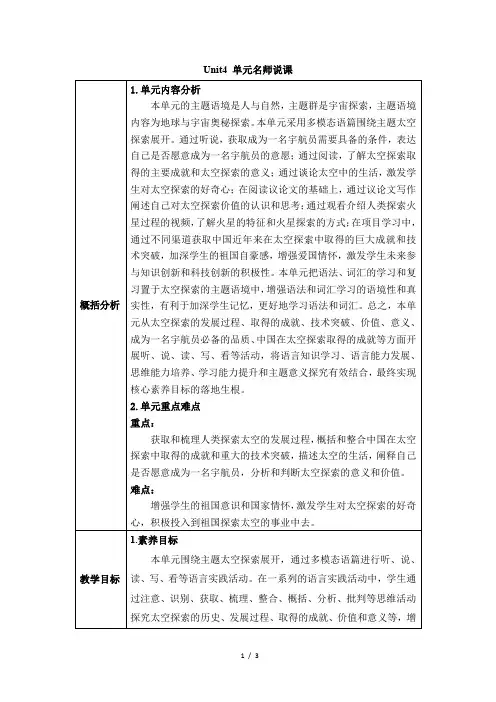
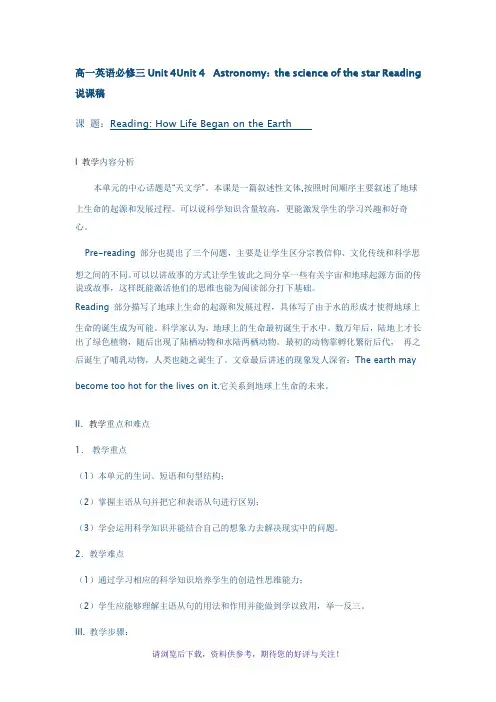
高一英语必修三Unit 4Unit 4 Astronomy:the science of the star Reading 说课稿课题:Reading: How Life Began on the EarthI 教学内容分析本单元的中心话题是“天文学”。
本课是一篇叙述性文体,按照时间顺序主要叙述了地球上生命的起源和发展过程。
可以说科学知识含量较高,更能激发学生的学习兴趣和好奇心。
Pre-reading 部分也提出了三个问题,主要是让学生区分宗教信仰、文化传统和科学思想之间的不同。
可以以讲故事的方式让学生彼此之间分享一些有关宇宙和地球起源方面的传说或故事,这样既能激活他们的思维也能为阅读部分打下基础。
Reading 部分描写了地球上生命的起源和发展过程,具体写了由于水的形成才使得地球上生命的诞生成为可能。
科学家认为,地球上的生命最初诞生于水中。
数万年后,陆地上才长出了绿色植物,随后出现了陆栖动物和水陆两栖动物。
最初的动物靠孵化繁衍后代,再之后诞生了哺乳动物,人类也随之诞生了。
文章最后讲述的现象发人深省:The earth maybecome too hot for the lives on it.它关系到地球上生命的未来。
II.教学重点和难点1.教学重点(1)本单元的生词、短语和句型结构;(2)掌握主语从句并把它和表语从句进行区别;(3)学会运用科学知识并能结合自己的想象力去解决现实中的问题。
2.教学难点(1)通过学习相应的科学知识培养学生的创造性思维能力;(2)学生应能够理解主语从句的用法和作用并能做到学以致用,举一反三。
III. 教学步骤:Step 1 RevisionPurpose :Let the students have a clear awareness of the text.Revise the new words and phrases by a dictation.Asking questions:How many planets are there in solar system?What are they?Step 2. Fast readingPurpose: To get the list of the passage.To correctly understand some information given in the text.1. Ask Ss to read the text quickly and try to get the main idea of the text. Suggested Answer:The main idea of the text is the title — How life began on the earth. 2. Ask Ss to work in pairs and discuss the questions of Ex1 on P27. And then let them check the answers in pairs.Step 3. Intensive readingPurpose: to get the students to learn the details of the text.(1) Answer the questions:•When did the “Big Bang” happen?•What form was the earth the “Big Bang”?• What made up the earth’s atmosphere after the earth exploded?• How did water come into being on the earth?• What was important to the development of fish?• What made possible the rise of mammals on the earth?• Why are mammals different from all life forms in the past?(2)Fill in the chart about the order of development of life.Suggested Answers:①Small plants in water ②Shellfish and all sorts of fish ③Green plants on land④Insects(on land) ⑤Amphibians(on land and in water) ⑥forests ⑦reptiles(on land)⑧dinosaurs(on land) ⑨mammals(on land) ⑩human beingsStep 3 ExplanationPurpose:Help Ss analyze some difficult, long and complex sentences and guess the meanings of the new words.Ask the studentsto underline the difficult sentences and analyze them and take notes.Pick out all the useful expressions and copy them.Step 4 Read aloudAsk Ss to read the passage aloud after the tape and let them pay more attention to the pronunciations of each new sentence.Step 5 HomeworkPreview the next period.and recite the last three paragragh.。
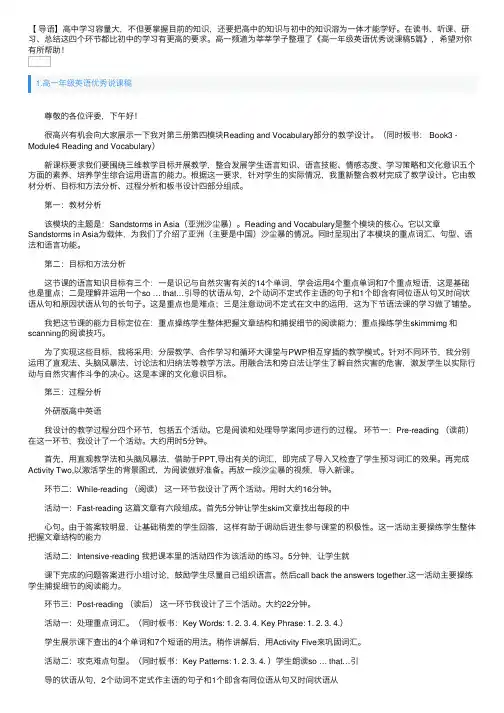
【导语】⾼中学习容量⼤,不但要掌握⽬前的知识,还要把⾼中的知识与初中的知识溶为⼀体才能学好。
在读书、听课、研习、总结这四个环节都⽐初中的学习有更⾼的要求。
⾼⼀频道为莘莘学⼦整理了《⾼⼀年级英语优秀说课稿5篇》,希望对你有所帮助!1.⾼⼀年级英语优秀说课稿 尊敬的各位评委,下午好! 很⾼兴有机会向⼤家展⽰⼀下我对第三册第四模块Reading and Vocabulary部分的教学设计。
(同时板书: Book3 -Module4 Reading and Vocabulary) 新课标要求我们要围绕三维教学⽬标开展教学,整合发展学⽣语⾔知识、语⾔技能、情感态度、学习策略和⽂化意识五个⽅⾯的素养,培养学⽣综合运⽤语⾔的能⼒。
根据这⼀要求,针对学⽣的实际情况,我重新整合教材完成了教学设计。
它由教材分析、⽬标和⽅法分析、过程分析和板书设计四部分组成。
第⼀:教材分析 该模块的主题是:Sandstorms in Asia(亚洲沙尘暴)。
Reading and Vocabulary是整个模块的核⼼。
它以⽂章Sandstorms in Asia为载体,为我们了介绍了亚洲(主要是中国)沙尘暴的情况。
同时呈现出了本模块的重点词汇、句型、语法和语⾔功能。
第⼆:⽬标和⽅法分析 这节课的语⾔知识⽬标有三个:⼀是识记与⾃然灾害有关的14个单词,学会运⽤4个重点单词和7个重点短语,这是基础也是重点;⼆是理解并运⽤⼀个so … that…引导的状语从句,2个动词不定式作主语的句⼦和1个即含有同位语从句⼜时间状语从句和原因状语从句的长句⼦。
这是重点也是难点;三是注意动词不定式在⽂中的运⽤,这为下节语法课的学习做了铺垫。
我把这节课的能⼒⽬标定位在:重点操练学⽣整体把握⽂章结构和捕捉细节的阅读能⼒;重点操练学⽣skimmimg 和scanning的阅读技巧。
为了实现这些⽬标,我将采⽤:分层教学、合作学习和循环⼤课堂与PWP相互穿插的教学模式。
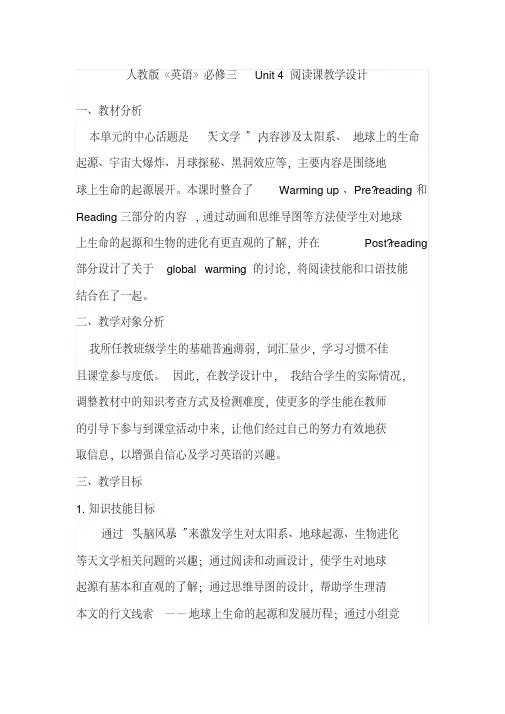
人教版《英语》必修三Unit 4阅读课教学设计一、教材分析本单元的中心话题是“天文学”,内容涉及太阳系、地球上的生命起源、宇宙大爆炸、月球探秘、黑洞效应等,主要内容是围绕地球上生命的起源展开。
本课时整合了Warming up、Pre?reading和Reading三部分的内容, 通过动画和思维导图等方法使学生对地球上生命的起源和生物的进化有更直观的了解,并在Post?reading 部分设计了关于global warming的讨论,将阅读技能和口语技能结合在了一起。
二、教学对象分析我所任教班级学生的基础普遍薄弱,词汇量少,学习习惯不佳且课堂参与度低。
因此,在教学设计中,我结合学生的实际情况,调整教材中的知识考查方式及检测难度,使更多的学生能在教师的引导下参与到课堂活动中来,让他们经过自己的努力有效地获取信息,以增强自信心及学习英语的兴趣。
三、教学目标1. 知识技能目标通过“头脑风暴”来激发学生对太阳系、地球起源、生物进化等天文学相关问题的兴趣;通过阅读和动画设计,使学生对地球起源有基本和直观的了解;通过思维导图的设计,帮助学生理清本文的行文线索——地球上生命的起源和发展历程;通过小组竞赛的方式,让学生积极思考并回答阅读理解中的问题;通过小组讨论,使学生思考并表达自己的想法,提高说的技能。
2. 情感态度价值观通过学习本篇文章,让学生了解地球上生命的起源及生物进化的过程,培养学生对科学的兴趣,激发学生探索科学的热情,并增强学生保护地球的意识。
四、教学重点与难点1. 熟悉与天文学相关的一些单词和短语,特别是要能认读表示八大行星的单词及与地球生命起源相关的重点词汇。
2. 阅读文章,了解地球生命的起源。
五、教学过程Step 1 Warming?up (3 mins)What science subjects do you know?What is Astronomy?Astronomy is the scientific study of the universe and the heaven bodies (such as the sun, the moon, and stars), gas, and dust within it.In solar system there are eight planets, can you name them?Mercury Venus Earth MarsJupiter Saturn Uranus Neptune【设计意图】通过“头脑风暴”的形式引入该单元话题,让学生了解太阳系及其八大行星,激发学生进一步了解天文学的兴趣。
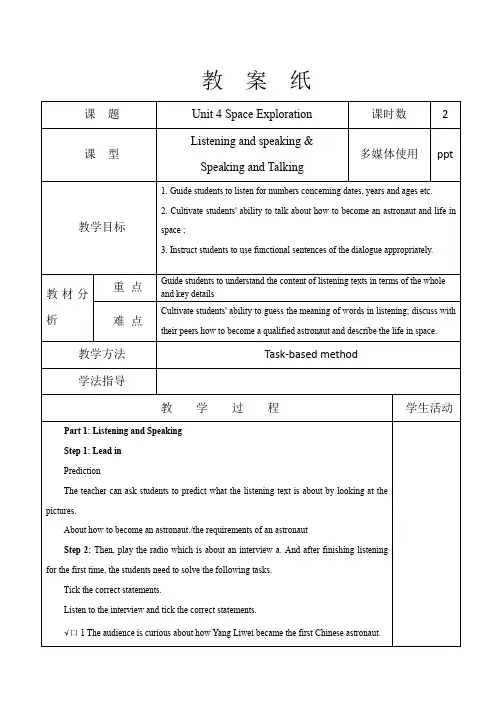
教案纸教案纸教案纸二、不定式作状语1.结果状语不定式作结果状语常表示出乎意料的结果。
常用于下列结构中:only to do; enough to do (足够做……); too ... to ... (太……而不能……); so/such ... as to ... (如此……以至于……)。
He hurried to the railway station, only to find the train had left.他匆忙赶到火车站,结果发现火车已经开走了。
He was so tired as to be unable to walk.=He was too tired to walk.他累得走不动了.【点津】现在分词短语作结果状语常常表示“自然而然、意料之中或顺理成章”的结果。
It hasn't rained for a month, making the crops hard to grow.一个月没下雨了导致庄稼很难生长。
2.目的状语不定式作目的状语主要表示某一动作或状态的目的。
常用于下列结构中:only to (仅仅为了); in order to; so ... as to; so (such) ... as to ... (如此……以便……)He ran so fast as to catch the first bus.他飞快地跑以便赶上第一班车。
I come here only to say goodbye to you.我来仅仅是向你告别。
【点津】 1.不定式的复合结构作目的状语,当不定式或不定式短语有自己的执行者时,要用不定式的复合结构即在不定式或不定式短语之前加for +名词或宾格代词作状语。
He opened the door for the children to come in.他开门让孩子们进来。
目的状语从句与不定式的转换英语中的目的状语从句,还可以变为不定式或不定式短语作状语,从而使句子在结构上得以简化。
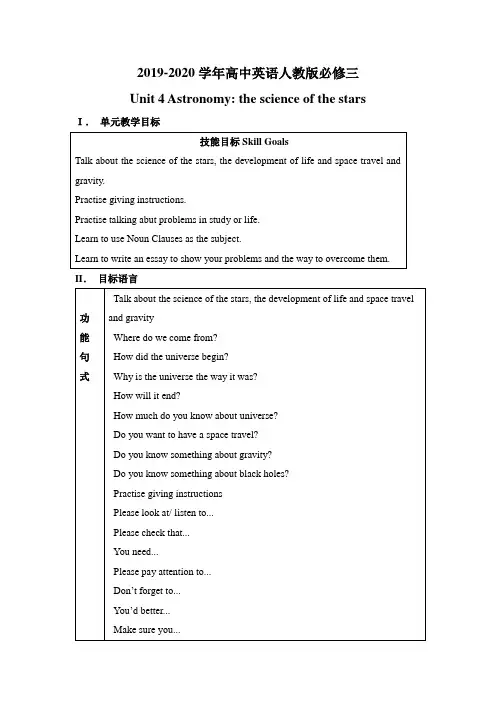
2019-2020学年高中英语人教版必修三Unit 4 Astronomy: the science of the stars I.单元教学目标II.目标语言III.教材分析与教材重组1. 教材分析本单元以astronomy: the science of the stars, the development of life, space travel and gravity为话题,通过本单元的几篇阅读材料使学生对以上问题有所了解,并通过文章中的一些探讨性的问题,比如,The earth may become too hot for the lives on it. Then what will our future be? 使学生更好地了解我们的地球和我们的生活环境,并引发对“地球的将来如何”的热烈讨论,通过这些讨论激发学生对天文学了解和探究的强烈兴趣。
通过讨论登月球需要的物品和可能遇到的困难学会提出问题和解决问题的表达方法,并能就此写出一篇表达合理思路清晰的短文。
1.1 WARMING UP以讨论的形式通过三组问题引导学生讨论边缘科学,讨论科学的方法以及要成为真正的科学家所必须掌握的技能。
1.2 PRE-READING 主要让学生弄清楚什么是科学思想,什么是宗教信仰或文化传统。
在探讨生命起源的科学道理之前,让学生以听故事或讲故事的方式,交流有关宇宙的起源的种种传说,既有趣味性,又能调动学生的相关知识,激活学生的思维。
1.3 READING 讲述了地球上生命的起源。
水的形成使得地球有别于其他星球,它使得地球上生命的诞生成为可能。
科学家认为,地球上的生命首先诞生于水中,上百万年后,陆地上才长出绿色植物,随后出现了陆栖动物和水陆两栖动物。
最初的动物靠孵化繁衍后代,后来出现了哺乳动物,人类也随之诞生了。
文章最后讲了令人深省的问题:The earth may become too hot for the lives on it.1.4 COMPREHENDING通过四个选择填空题检测学生对本文核心问题的理解:地球上生命的起源和延续需要哪些条件?随后通过排序的方式帮助学生弄清本文的行文线索,也就是地球上生命的起源和发展历程。
篇一:高一英语说课稿范文必修1 unit4 earthquakes 说课稿高一英语说课稿范文必修1 unit4 earthquakes 说课稿一、说课标新课程标准的三维教学观,具体到英语学科就是要整合发展学生语言技能、语言知识、情感态度、学习策略和文化意识五个方面的素养,培养学生综合运用语言的能力。
指出:“教师在教学才过程中应与学生积极互动、共同发展。
教师应尊重学生的人格,关注个体差异,满足不同学生的学习需要,创设能引导学生主动参与的教育环境,激发学生的学习积极性,培养学生掌握和运用知识的态度和能力,使每个学生都能得到充分的发展。
因此,本课的设计重点是:帮助学生形成自主、合作、探究的学习模式,掌握阅读的一些基本技巧,让每个学生在原有的基础上都学有所得。
二、说教材(一)教材地位和教学内容分析本课是高一必修模块1第4单元的阅读课型,这单元围绕earthquakes这一主题开展听、说、读、写多种教学活动。
reading设计为本单元的第2课时。
本课型是单元整体教学的重要环节,为学生的语言学习、语法学习提供了载体,并且是学生获取信息的主要来源。
“reading――― a night the earth didn’t sleep”具体描写1976年唐山大地震的震前、震中和震后。
本篇文章词汇量大,运用了大量的动词、复杂的数字,出现许多定语从句,篇幅较长,并且采用一些修辞手法,对学生的语言阅读能力提出了更高的要求。
但文章的结构较明显,较容易归纳出各部分的中心词。
(二)教学目标1. 语言知识目标:a)使学生了解自然灾害的相关词汇,并掌握复杂数字的表达法。
b)学习掌握与地震相关的词汇,如:shake,well,rise,smelly,pond,pipe,burst,canal,steam,ruin,injure,destroy,brick,dam ,useless,steel,shock,quake,rescue,electricity,disaster,army,organize,bury,coal,m ine,shelter,fresh,percent等,以及 right away, at an end, dig out, give out, thousands of以及一些优美句子的赏析。
主备教师:雷欣二次备课教师:编号:19课题:Unit4 Astronomy: the science of the starsPeriod 1 Wanrming Up and Reading教学目标:1. Develop students’ reading ability and let them learn differentreading skills.2. Enable students to know about the development of the earth.教学难点:1. Enable students to understand the passage and know aboutthe development of the earth.2. Let students learn how to use different reading skills fordifferent reading purposes.教学方法: Skimming, discussion, individual work and group work.教学过程:【自研课导学】1.Let students learn the useful words and expressions in this part:astronomy, system, religion,theory, atom, billion, globe, violent, atmosphere.2.Get students to learn about the development of the earth.【展示课导学】Step1: Leading-inHave a free talk with students.1. Let students discuss the following questions:Who are our ancestors?Do you know what it was like before life appeared on the earth?Do you know how life began on the earth?Do you want to get more information?2.Tell students:Today we will learn something about how life began on the earth. Turn toPage 25. Let’s come to Warming Up first.Step2: Warming upwith their partners.1.In our solar system eight planets circle around the sun. What are they? Canyou match the names with the planets?(P25)2.What interests you in astronomy? Do you know any questions that astronomersare interested in?Step3: Pre-reading1. Get students to discuss the questions with their partners.do you know about it?2) Each religion and culture has its own ideas about how life beganon earth.What do you know about them?2.will be about.Step4 : Reading1. Fast reading :Scanningthrough the whole text and answer questions:1). What is the passage about?2). What’s the main idea of the text?2. Detail readingChoose the best answer to each question according to the text.1). What is important for the beginning of life?A. The water on the earth.B. The earth’s atmosphere.C. The form of forests.D. Dissolving harmful gases.2) Which of the following appeared on the earth first?A. Insects.B. Reptiles.C. Amphibians.D. Shellfish and fish.3) Which of the following statements true?A. Water still exists on Mars.B. The earth’s atmosphere is made up of oxygen and nitrogen.C. The earth had dissolved the harmful atmosphere into the oceans and seas.D .Plants provide oxygen to the earth.4) What is the passage mainly about?A. The appearance and development of life on the earth.B. The birth of the earth.C. Why dinosaurs died out.D. The fact that human begings caused global warming.Suggested answers:(1) A (2) D (3) D (4) A【板书设计】_____________________________________________________ _____________________________________________________ __________________________________________________________________________________________________________【教学反思】______________________________________________________________________________________________________________________________________________________________。
Unit4 Astronomy: the science of the starsReading: How Life Began on the Earth InterpretationGood morning, ladies and gentlemen. It’s my great honor and pleasure to be here sharing my lesson with you.I have been ready to begin this representation with six parts. Analysis of the teaching material, the students, the teaching aims, the important and difficult points, the studying methods, and the teaching procedure.Part 1 Teaching MaterialThe content of my lesson is New Senior English for China Book_3__ Unit_4_. This unit is about_Astronomy: the science of the stars. By studying of this unit, we’ll enable students to know sth. about astronomy and science of the stars and develop the interest in_science and learning English.At the same time, let the students learn how to_use the noun clauses as the subject and distinguish the noun clauses as the subject and as the object. From this lesson, it starts with warming up, pre-reading, reading and comprehending part. (As we all know, reading belongs to the input during the process of the language learning. The input has great effect on output, such as speaking and writing.) Therefore, this lesson is in the important position of this unit. If the Ss can master it well, it will be helpful for them to learn the rest of this unit.Part2 Analysis of the studentsThe students in Senior High School, grade one have already learned English for years, they can speak and communicate with their friends in English. They are moderate, mature and sensitive. They are highly motivated in learning English and have the ability to learn by themselves. Furthermore, the topic of this unit is about astronomy, which is full of mystery, the students will have greater interest in learning it. However, the differences in english level among students is the biggest challenge. Therefore the teacher should provide enough background information to make them better understand the text. Therefore, I will adopt appropriate teaching methods to arouse their interest in learning.Part 3 Teaching AimsAccording to the new standard curriculum and the syllabus (新课程标准和教学大纲), and after studying the teaching material, the teaching aims are the followings: 1.Knowledge objects (语言目标:语音,词汇,语法,功能,话题)(1)The Ss can master the usage of the important words and expressions.(2)The Ss can use the noun clauses as the subject and as the object in the proper situation.(3)The Ss can understand the content of the lesson, talk about astronomy and get their own idea about protecting the earth.2.Ability objects (技能目标:听,说,读,写)(1) To develop the Ss’ abilities of listening, speaking, reading and writing(2) To guide Ss to set up effective studying strategies.(3) To improve the student’s reading ability, especially their skimming and sca nning ability.(4) To train the Ss’ abilities of studying by themselves and cooperating .3.Emotion or moral objects (情感目标:兴趣,自信,合作,爱国,国际视野) (1)By completing the task, the Ss increase their interest in astronomy and science and set up self-confidence in learning English and protect the earth in proper ways.(2)Teach the Ss to cooperate with others and cultivate the patriotic spirit and international visions, put the moral education in the language study.Part 4 the Important and Difficult PointsBased on the requirement of the syllabus. The important points are_new words and expressions in the text, such as theory, billion, violent,fundamental, give birth to etc. The difficult points are the usages of noun clauses as the subject and as the object, how to distinguish these two kinds of noun clauses.Part 5 Teaching MethodsAs is known to us all, a good teaching method requires that the teacher should help Ss develop good sense of the English language. For achieving these teaching aims, (after the analysis of the teaching material and teaching aims,) I will use the following methods according to the modern social communication teaching theories(现代社会交际教学理论) .municative Approach(交际教学法)2. Whole Language Teaching(整体语言教学法)3. Task-based Language Teaching (任务教学法)4. Total Situational Action (情景教学) a “scene —activity” teaching method , it establishes a real scene and the interaction between the teacher and the Ss. At the same time, CAI (电脑辅助教学) can provide a real situation with its sound and picture, it can develop the Ss creativity in learning English.Part 6 Teaching ProcedureStep1.Lead-in.(__10___min)1.Ask students to read the questions in warming up part, then discuss with their group members. After that ask several representatives to give their ideas.2. Ask students: Do you know any big events in the astronomy in history? If you know, can you tell us sth. about them? Are you interested in science? Do you know how earth began to form?Purpose of my design: (1) to catch Ss’ attention abou t the class/topic/passage.(2)To set up suspense/develop interest in the astronomy and the science.Step 2. Pre-readingTask 1. ( pair work, __3___min)Let Ss read the questions1-2 in pre-reading part, then work in pairs to find out the answers to the questions, then ask several students to express their ideas.Task 2. (Individual work, __2___min)Ask students to read the title and look at the pictures. Predict what the reading will be about. Then ask one student to say his/her guess.Now, let’s see what happened in the text./ let’s check whether it is right or not. Purpose of my design: (1) to get to know something about how life began on the earth.(2) To have a better understanding about the importance of protecting the earth. Step 3. While-readingTask 1. (Individual work __5___min)Skimming: Ss should read the material fast to find out the main idea/topic sentence for each paragraph.Para 1 ___________________Para 2 ___________________Para 3 ___________________ …Scanning: Guide Ss to read the material carefully and take some important notes, then finish the exercise 2 on P27.Task 4. (Individual work, pair work, group work, class work; __5___min) Scanning: Ask Ss to read the material carefully and find out the correct answers to finish the following questions.This text can mainly divided into two stagesStage 1 : The development of the earth(para.1-3)(1)After the Big Bang, what was the earth like?(2)What happened next?(3)(4)What did the water vapour and gases form?(5)What appeared as the earth cooled down?(6)(7)Why is water so important for the beginning of life?Stage 2 : The development of life(para.4-5)1.What life developed after water appeared?2.What life developed in water next?3.What about the life on land?4.5.What life developed next on land?6.7.What life developed after forests appeared?8.What life developed after dinosaurs?9.What life developed after mammals?Purpose of my design: Enable students to understand the given material better by using different reading skills. And proper competition can arouse the Ss’ interest in English learning. “Task-based” teaching method is used here to develop the Ss’ ability of communication and also their ability of co-operation will be well trained.Step 4. Post-readingTask 1. (Individual work __3___min)Ask Ss to close books and finish the summary according to their notes.Retell the story /Sum up the passage in Ss’ own words according to the chart.Task 2. (group work, __7___min)Discuss with other group members and then choose a reporter to share their opinions about the questions with the whole class.How life began on earth is one of the biggest puzzles that scientists found hard to solve.1.What other puzzles are hidden in the passage?2. According to the evolution of life on the earth, why was the earth different from the other planets?3. Can you imagine the reason why dinosaurs disappeared?4.5. As the earth is heavily polluted by us humans, what should we do to make up for it?Purpose of my design: I think If the Ss can finish this task well, they will benefit a lot in their spoken English. Most Ss can take their parts in the activities, especially for the Ss who have trouble in English study.Step 5. Homework1. Review the new words and expressions in the text2. Finish the exercises 1-3 on P28.Purpose of my design: Homework is so important and necessary for to master the knowledge they learned after class. It will check whether the Ss achieve the teaching aims.。
Unit1 Festivals around the world教材分析本单元以节日为话题,介绍了世界各地的一些节日、含义、由来和民俗。
通过本单元的学习,可以帮助学生更多地了解节日、体味文化;同时又能教育学生理解、尊重不同的文化和习俗。
通过本单元的语言技能训练,要求学生学会使用请求以及感谢的表达法。
This unit talks about festivals of many kinds in different parts of the world. The first reading briefly describes four different kinds of festivals.Ss can not only improve their English learning ab ility but also know more about the festivals home and abroad. At the same time, we should use th e opportunity to have the Ss think about the reasons for festivals and the reasons for different wa ys of celebrations.1. Warming Up 要求学生以小组形式完成一个表格填充,列出中国的五个节日和这些节日的时间、庆祝的内容以及节日里人们的所作所为。
激发学生的阅读兴趣,为本单元Reading部分的世界节日做好铺垫。
. Pre-reading 通过若干个问题了解学生对节日的认识,比如:你最喜欢的节日是什么?你喜欢与家人还是与朋友共度佳节?你喜欢节日的哪部分——音乐、拜访朋友,可看的还是可吃的?3. Reading 由五篇小短文组成,分别介绍古代节日、亡灵节、纪念名人的节日、丰收节和春天的节日等,使学生了解节日的由来及其存在的意义。
高一英语必修三Unit 4Unit 4 Astronomy:the science of the star Reading 说课稿
课题:Reading: How Life Began on the Earth
I 教学内容分析
本单元的中心话题是“天文学”。
本课是一篇叙述性文体,按照时间顺序主要叙述了地球上生命的起源和发展过程。
可以说科学知识含量较高,更能激发学生的学习兴趣和好奇心。
Pre-reading 部分也提出了三个问题,主要是让学生区分宗教信仰、文化传统和科学思想之间的不同。
可以以讲故事的方式让学生彼此之间分享一些有关宇宙和地球起源方面的传说或故事,这样既能激活他们的思维也能为阅读部分打下基础。
Reading 部分描写了地球上生命的起源和发展过程,具体写了由于水的形成才使得地球上生命的诞生成为可能。
科学家认为,地球上的生命最初诞生于水中。
数万年后,陆地上才长出了绿色植物,随后出现了陆栖动物和水陆两栖动物。
最初的动物靠孵化繁衍后代,再之后诞生了哺乳动物,人类也随之诞生了。
文章最后讲述的现象发人深省:The earth may become too hot for the lives on it.它关系到地球上生命的未来。
II.教学重点和难点
1.教学重点
(1)本单元的生词、短语和句型结构;
(2)掌握主语从句并把它和表语从句进行区别;
(3)学会运用科学知识并能结合自己的想象力去解决现实中的问题。
2.教学难点
(1)通过学习相应的科学知识培养学生的创造性思维能力;
(2)学生应能够理解主语从句的用法和作用并能做到学以致用,举一反三。
III. 教学步骤:
Step 1 Revision
Purpose :Let the students have a clear awareness of the text.
Revise the new words and phrases by a dictation.
Asking questions:
How many planets are there in solar system?
What are they?
Step 2. Fast reading
Purpose: To get the list of the passage.
To correctly understand some information given in the text.
1. Ask Ss to read the text quickly and try to get the main idea of the text.
Suggested Answer:
The main idea of the text is the title — How life began on the earth. 2. Ask Ss to work in pairs and discuss the questions of Ex1 on P27. And then let them check the answers in pairs.
Step 3. Intensive reading
Purpose: to get the students to learn the details of the text.
(1) Answer the questions:
•When did the “Big Bang” happen?
•What form was the earth the “Big Bang”?
•What made up the earth’s atmosphere after the earth exploded?
•How did water come into being on the earth?
•What was important to the development of fish?
•What made possible the rise of mammals on the earth?
•Why are mammals different from all life forms in the past?
(2)Fill in the chart about the order of development of life.
Suggested Answers:
① Small plants in water ② Shellfish and all sorts of
fish ③ Green plants on land
④ Insects(on land) ⑤ Amphibians(on land and in water) ⑥forests ⑦ reptiles(on land)
⑧ dinosaurs(on land) ⑨ mammals(on land) ⑩ human beings
Step 3 Explanation
Purpose:Help Ss analyze some difficult, long and complex sentences and guess the meanings of the new words.
Ask the studentsto underline the difficult sentences and analyze them and take notes.
Pick out all the useful expressions and copy them.
Step 4 Read aloud
Ask Ss to read the passage aloud after the tape and let them pay more attention to the pronunciations of each new sentence.
Step 5 Homework
Preview the next period.and recite the last three paragragh.
(注:文档可能无法思考全面,请浏览后下载,供参考。
可复制、编制,期待你的好评与关注!)。